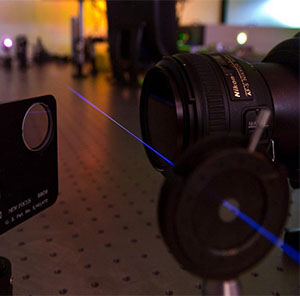The Perfect Valentine’s Day Gift: High Power Mirror for Laser Filamentation
Tech Blog Thursday mixes serious science with humor and easily recognizable analogies for the less-than-scientifically inclined. The purpose of this blog series is to illustrate the potential of not-yet-commercialized technology and encourage excitement about the possibilities.

A long-exposure photograph of the plasma emission that results during filamentation. Within a dark laboratory, the filament emission was visible to the dark adapted eye—detection primarily by the rods of the human eye and not the cones. The blue color was characteristic of molecular nitrogen emission bands in the 300 nm to 400 nm spectral region.
February 5, 2015
UCF Tech Transfer wants to help you pick the perfect gift for your special someone this Valentine’s Day.
On February 14th, they will be expecting a gift that shows how much you care, how well you know them, and the expectations you have of your future together. You need something enduring, and your special someone deserves the very best.
The gift can’t be what everyone else has, but you wouldn’t want to chase trends either. It should be the best of both worlds: a twist on a classic. It should be strong and made to last, and shine so brilliantly it is impossible to ignore. Your gift should reflect everything you cherish about your loved one, and incorporate noble metals and gems.
What you need is a high-power mirror for laser filamentation.
Laser filamentation, the nonlinear optics phenomenon of self-focusing and propagation of a beam, requires a pulse of high-peak-power laser radiation that exceeds the damage threshold of conventional laser mirrors. The new mirror can surpass the damage threshold of conventional mirrors because of its composition, a 500 nm-thick layer of 99.99999% pure gold deposited on a smooth sapphire substrate. Gold, among other noble metals, possesses qualities that allow energy to be more evenly distributed so that energy per unit area doesn’t exceed the material damage threshold.
Your sweetheart will connect the dots in an instant when you show that your love for them that keeps you focused is so powerful it needs a next-generation, patent-pending high-power laser mirror.
This high-power laser mirror is even more attractive when you consider its simplicity to manufacture—relative simplicity, we don’t recommend building it yourself—and versatility beyond laser filamentation, for all of your other high-power laser beam redirection needs.
To learn more about partnering with UCF to bring this innovation to market, contact John Miner.